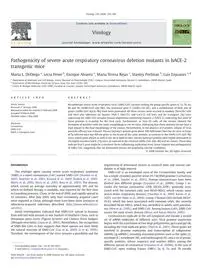
2008 Pathogenicity of severe acute respiratory coronavirus deletion mutants in hACE-2 transgenic mice PDF
Preview 2008 Pathogenicity of severe acute respiratory coronavirus deletion mutants in hACE-2 transgenic mice
Pathogenicity of severe acute respiratory coronavirus deletion mutants in hACE-2 transgenic mice Marta L. DeDiego a, Lecia Pewe b, Enrique Alvarez a, Maria Teresa Rejas c, Stanley Perlman b, Luis Enjuanes a,⁎ a Department of Molecular and Cell Biology, Centro Nacional de Biotecnología (CSIC), Campus Universidad Autónoma, Darwin 3, Cantoblanco, 28049 Madrid, Spain b Department of Microbiology, University of Iowa, Iowa City, Iowa 52242, USA c Centro de Biología Molecular (CSIC-UAM), Facultad de Ciencias, Campus Universidad Autónoma, Cantoblanco, 28049 Madrid, Spain a r t i c l e i n f o a b s t r a c t Article history: Received 17 January 2008 Returned to author for revision 21 February 2008 Accepted 10 March 2008 Available online 2 May 2008 Recombinant severe acute respiratory virus (SARS-CoV) variants lacking the group specific genes 6, 7a, 7b, 8a, 8b and 9b (rSARS-CoV-Δ[6–9b]), the structural gene E (rSARS-CoV-ΔE), and a combination of both sets of genes (rSARS-CoV-Δ[E,6–9b]) have been generated. All these viruses were rescued in monkey (Vero E6) cells and were also infectious for human (Huh-7, Huh7.5.1 and CaCo-2) cell lines and for transgenic (Tg) mice expressing the SARS-CoV receptor human angiotensin converting enzyme-2 (hACE-2), indicating that none of these proteins is essential for the viral cycle. Furthermore, in Vero E6 cells, all the viruses showed the formation of particles with the same morphology as the wt virus, indicating that these proteins do not have a high impact in the final morphology of the virions. Nevertheless, in the absence of E protein, release of virus particles efficacy was reduced. Viruses lacking E protein grew about 100-fold lower than the wt virus in lungs of Tg infected mice but did not grow in the brains of the same animals, in contrast to the rSARS-CoV-Δ[6–9b] virus, which grew almost as well as the wt in both tissues. Viruses lacking E protein were highly attenuated in the highly sensitive hACE-2 Tg mice, in contrast to the minimal rSARS-CoV-Δ[6–9b] and wt viruses. These data indicate that E gene might be a virulence factor influencing replication level, tissue tropism and pathogenicity of SARS-CoV, suggesting that ΔE attenuated viruses are promising vaccine candidates. © 2008 Elsevier Inc. All rights reserved. Keywords: Coronavirus SARS-CoV hACE-2 transgenic mice Introduction The etiologic agent causing severe acute respiratory syndrome (SARS) is a novel coronavirus (CoV) named SARS-CoV (Drosten et al., 2003; Fouchier et al., 2003; Ksiazek et al., 2003; Kuiken et al., 2003; Marra et al., 2003; Peiris et al., 2003; Rota et al., 2003). The disease, which caused an average mortality of approximately 10% and for which no defined therapy is available, was reported for the first time in Guandong province, China, at the end of 2002, and rapidly spread to 32 countries. After July 2003, only four community acquired cases were reported in China, although there have been three instances of laboratory-acquired infections described (http://www.who.int/csr/ sars/en/). Initial investigations indicated that SARS-CoV spread to humans from infected wild animals in wet markets of Southern China, such as Himalayan palm civets (Paguna larvatta) and Chinese ferret badgers (Melogale moschatta) (Guan et al., 2003). Nevertheless, the recognition of SARS-like CoVs in bats suggests that these species are most likely the natural reservoir of SARS-CoV (Lau et al., 2005; Li et al., 2005). Therefore, the reemergence of the virus remains a possibility and the engineering of attenuated viruses as research tools and vaccine can- didates is of high interest. SARS-CoV is an enveloped virus of the Coronaviridae family, and has a single-stranded, positive sense 29.7 kb RNA genome (Gorbalenya et al., 2004; Snijder et al., 2003). Human coronaviruses have been divided into different groups (Enjuanes et al., 2008b). Group 1 in- cludes the human coronavirus 229E (HCoV-229E), generally asso- ciated with the common cold, and HCoV-NL63, which causes more severe lower respiratory diseases (Fouchier et al., 2004; Kaiser et al., 2005; van der Hoek et al., 2004). Group 2 human CoVs include HCoV- OC43, which has been associated with common colds, the recently described HCoV-HKU1, which was identified in adults with pneumo- nia (Woo et al., 2005), and SARS-CoV. Among human CoVs, SARS-CoV causes the most severe disease (Weiss and Navas-Martin, 2005). Coronaviruses replicate in the cell cytoplasm and encode a nested set of mRNA molecules of different sizes. Viral genome expression begins with the translation of two large polyproteins, pp1a and pp1ab, including the viral replicase genes (Thiel et al., 2003). These genes are involved in genome replication and transcription of subgenomic mRNAs (sg mRNAs), encoding structural proteins such as the spike (S), envelope (E), membrane (M), and nucleocapsid (N), and a set of group- specific proteins, whose sequence and number differs among the different species of coronavirus (Enjuanes et al., 2008b). In the case of SARS-CoV, open reading frames (ORFs) 3a, 6, 7a, and 7b encode Virology 376 (2008) 379–389 ⁎ Corresponding author. Fax: +34 91 585 4915. E-mail address:
